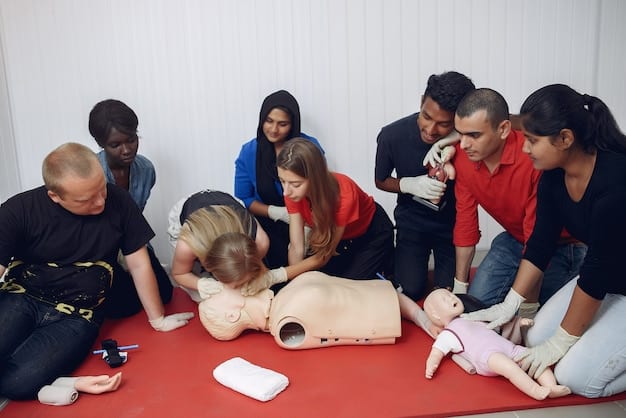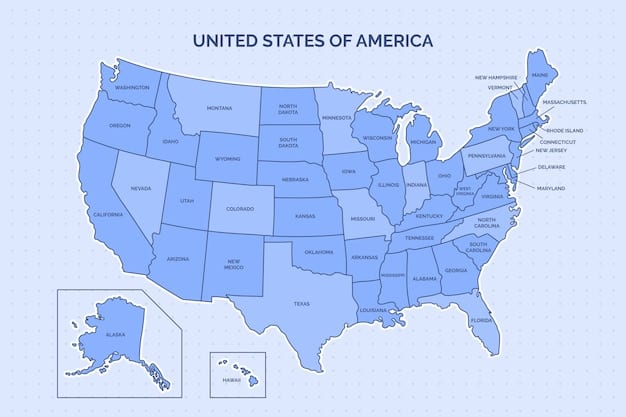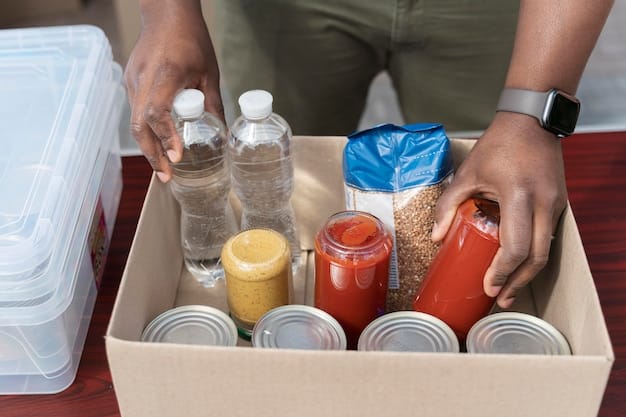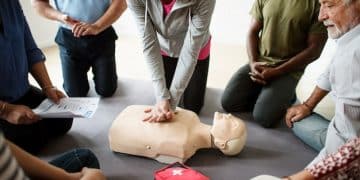Emergency Preparedness Week 2025: Your Guide to Safety

Emergency Preparedness Week 2025 is a crucial opportunity to ensure you and your community are ready for unexpected events, offering resources and guidance to enhance your resilience and safety.
Are you ready for the unexpected? Emergency Preparedness Week 2025 is the perfect time to assess your readiness and take proactive steps for your safety and the well-being of your community.
What is Emergency Preparedness Week?
Emergency Preparedness Week is an annual event dedicated to raising awareness about the importance of being prepared for emergencies. It’s a time for individuals, families, and communities to learn how to protect themselves and their property during various types of disasters and emergencies. The week emphasizes the need for planning, preparation, and community involvement.
During Emergency Preparedness Week 2025, various activities and resources are made available to help people understand risks and take action. This includes workshops, online resources, community drills, and public awareness campaigns. The goal is to empower everyone to be better prepared and more resilient in the face of adversity.
Why is Emergency Preparedness Week Important?
Emergency preparedness is often overlooked until a crisis hits. Emergency Preparedness Week serves as a vital reminder to proactively prepare for the unexpected. Here’s why it’s so important:
- Saves Lives: Being prepared can significantly increase your chances of survival during an emergency. Knowing what to do and having the necessary supplies can make all the difference.
- Reduces Impact: Preparedness can minimize the impact of a disaster on your family and community. This includes reducing injuries, property damage, and emotional distress.
- Community Resilience: When individuals are prepared, the entire community becomes more resilient. This helps in quicker recovery efforts and reduces the burden on emergency services.
- Peace of Mind: Knowing that you have a plan and the necessary resources can provide peace of mind, reducing anxiety and stress during uncertain times.
Emergency Preparedness Week is not just about individual actions; it’s about fostering a culture of preparedness throughout the community. By participating in events and spreading awareness, you contribute to a safer, more resilient society.
Understanding Potential Emergencies in Your Area
The first step in being prepared is understanding the types of emergencies that are most likely to occur in your specific area. Different regions face different risks, and knowing these risks is crucial for effective planning. This understanding helps you tailor your preparedness efforts to address the most probable scenarios.
In many areas, common emergencies include natural disasters such as hurricanes, tornadoes, floods, and earthquakes. Other regions might be more susceptible to wildfires, extreme weather events, or even man-made disasters. Identifying these risks is essential for creating a comprehensive emergency plan.

Common Natural Disasters in the US
The United States faces a wide range of natural disasters, each posing unique challenges. Here’s a brief overview of some of the most common:
- Hurricanes: Coastal areas, particularly along the Atlantic and Gulf coasts, are prone to hurricanes. These storms bring strong winds, heavy rainfall, and storm surges.
- Tornadoes: The Midwest, often referred to as “Tornado Alley,” experiences frequent and severe tornadoes. These storms can cause widespread damage and pose significant safety risks.
- Earthquakes: The West Coast, especially California, is at high risk for earthquakes. These seismic events can cause ground shaking, tsunamis, and landslides.
- Floods: River basins and coastal regions are susceptible to flooding. Heavy rainfall, snowmelt, and coastal storms can all lead to floods, causing property damage and displacement.
By understanding the specific threats in your area, you can better prepare for potential emergencies. This includes developing evacuation plans, creating emergency kits, and staying informed about weather forecasts and alerts. Being aware and proactive is key to protecting yourself and your community.
Creating a Comprehensive Emergency Plan
A comprehensive emergency plan is a detailed strategy that outlines how you and your family will respond to various types of emergencies. This plan should include evacuation routes, communication methods, and meeting points. Creating such a plan is a proactive step that can significantly improve your safety and well-being during a crisis.
The process of creating an emergency plan involves several important steps. First, assess the potential risks in your area and identify the types of emergencies you are most likely to face. Next, develop a clear and concise plan that everyone in your family understands. Practice the plan regularly to ensure everyone knows what to do.
Key Components of an Emergency Plan
A well-structured emergency preparedness plan should include the following key elements:
- Evacuation Routes: Identify primary and secondary evacuation routes from your home and neighborhood. Ensure everyone knows the routes and can navigate them safely.
- Meeting Points: Designate a safe meeting point outside your home and another outside your neighborhood in case you need to evacuate. This ensures that everyone can find each other after an emergency.
- Communication Plan: Establish a communication plan that includes how you will contact each other if separated. This might involve designating an out-of-state contact person or using communication apps.
- Emergency Contacts: Keep a list of important emergency contacts, including local authorities, medical facilities, and family members. Ensure everyone has access to this list.
Developing a comprehensive emergency plan is a critical step in preparedness. By addressing these key components, you can create a resilient strategy that protects your family and community during emergencies.
Building an Emergency Supply Kit
An emergency supply kit, often referred to as a “go-bag,” is a collection of essential items that you and your family might need during an emergency. This kit should be easily accessible and contain enough supplies to sustain you for at least 72 hours. Building and maintaining an emergency supply kit is a fundamental aspect of preparedness.
The contents of your emergency supply kit should be tailored to your specific needs and the types of emergencies most likely to occur in your area. However, there are some basic items that should be included in every kit. These include water, food, first aid supplies, and essential documents.

Essential Items for Your Emergency Kit
Here are some must-have items for your emergency supply kit:
- Water: Store at least one gallon of water per person per day. Water is essential for hydration and sanitation.
- Food: Include non-perishable food items such as canned goods, energy bars, and dried fruits. Choose foods that are easy to prepare and have a long shelf life.
- First Aid Kit: A well-stocked first aid kit should include bandages, antiseptic wipes, pain relievers, and any personal medications.
- Flashlight and Batteries: A reliable flashlight is crucial for safety during power outages. Be sure to include extra batteries to ensure it remains functional.
An emergency supply kit is a critical resource during emergencies. By including these essential items and customizing your kit to meet your specific needs, you can enhance your ability to cope with unexpected events. Remember to check your kit regularly and replace expired items to ensure it remains effective.
Staying Informed and Connected
Staying informed about potential emergencies and maintaining communication with your community are vital aspects of preparedness. Access to reliable information can help you make informed decisions and take appropriate actions to protect yourself and your family. Communication ensures that you can stay connected with loved ones and receive timely updates from authorities.
There are several ways to stay informed about potential emergencies. One of the most effective methods is to monitor local news and weather reports. Additionally, signing up for emergency alerts and notifications can provide real-time updates about impending threats. Social media and community networks can also be valuable sources of information.
Effective Ways to Stay Informed
Here are some practical strategies for staying informed during emergencies:
- Local News: Regularly watch or listen to local news to stay updated on potential emergencies in your area.
- Emergency Alerts: Sign up for emergency alert systems provided by your local government to receive notifications via text, email, or phone.
- Weather Reports: Monitor weather forecasts to stay informed about potential severe weather events.
- Social Media: Follow local authorities and news outlets on social media for real-time updates during emergencies.
Staying informed and connected is crucial for effective emergency preparedness. By utilizing these strategies, you can ensure that you receive timely and accurate information, enabling you to make informed decisions and take appropriate actions to protect yourself and your community.
Engaging with Your Community
Engaging with your community is an important aspect of emergency preparedness. When communities work together, they are better equipped to respond to and recover from disasters. Community involvement fosters a sense of solidarity and mutual support, which can be invaluable during a crisis.
There are many ways to engage with your community in emergency preparedness efforts. One of the most effective methods is to participate in local preparedness programs and initiatives. These programs often provide training, resources, and opportunities for community members to work together. Additionally, volunteering with local emergency response organizations can make a significant difference.
Ways to Get Involved in Your Community
Here are some ways to get involved in your community’s emergency preparedness efforts:
- Attend Workshops: Participate in emergency preparedness workshops and training sessions offered by local organizations.
- Volunteer: Volunteer with local emergency response organizations such as the American Red Cross or community emergency response teams (CERT).
- Community Drills: Participate in community drills and exercises to practice emergency response procedures.
- Spread Awareness: Share information and resources about emergency preparedness with your neighbors and friends.
Engaging with your community is a powerful way to enhance emergency preparedness. By working together, communities can build resilience and provide support to those in need during times of crisis. Remember, a prepared community is a strong community.
Maintaining Your Preparedness
Emergency preparedness is not a one-time task but an ongoing process that requires regular maintenance and updates. It’s important to review and update your emergency plan, replenish your supply kit, and stay informed about potential risks. Consistent maintenance ensures that you remain ready for any unexpected event.
One of the most effective ways to maintain your preparedness is to establish a routine for reviewing and updating your emergency plan and supply kit. This routine should include checking expiration dates, replacing used items, and updating contact information. Additionally, staying informed about changes in local risks and emergency procedures is essential.
Tips for Maintaining Your Preparedness
Here are some practical tips for maintaining your emergency preparedness:
- Review Your Plan: Review your emergency plan at least once a year and update it as needed. Consider changes in your family’s needs, contact information, and potential risks.
- Check Your Kit: Inspect your emergency supply kit every six months to ensure that all items are in good condition and have not expired. Replace any used or expired items.
- Stay Informed: Stay informed about changes in local risks and emergency procedures. Monitor local news and emergency alert systems regularly.
- Practice: Practice your emergency plan with your family to ensure everyone knows what to do. Conduct drills periodically to reinforce emergency response procedures.
Maintaining your preparedness is a key to ensuring your safety and well-being during emergencies. By following these tips and making preparedness a regular part of your routine, you can enhance your ability to cope with unexpected events and protect yourself and your community.
| Key Point | Brief Description |
|---|---|
| ⚠️ Understand Risks | Identify local emergencies like hurricanes, tornadoes, or earthquakes. |
| 🏠 Create a Plan | Develop evacuation routes, meeting points, and communication strategies. |
| 🎒 Build a Kit | Prepare a 72-hour emergency kit with water, food, and first aid supplies. |
| 📢 Stay Informed | Monitor local news, weather, and emergency alerts for updates. |
Frequently Asked Questions
▼
Emergency Preparedness Week is an annual event dedicated to promoting awareness and preparedness for various types of emergencies and disasters, encouraging communities to take proactive measures.
▼
An emergency plan helps you and your family know what to do in different emergency scenarios, ensuring quick, safe responses and reducing potential harm during a crisis.
▼
An emergency kit should include water, non-perishable food, a first aid kit, a flashlight, a radio, extra batteries, personal hygiene items, and copies of important documents.
▼
Stay informed by monitoring local news, weather reports, and official emergency alerts through radio, TV, and online platforms to receive timely updates and instructions.
▼
Engage with your community by attending local preparedness workshops, volunteering with emergency response teams, and spreading awareness among neighbors to enhance overall resilience.
Conclusion
Emergency Preparedness Week 2025 is a critical reminder to take proactive steps to protect yourself, your family, and your community. By understanding potential risks, creating a comprehensive emergency plan, building an emergency supply kit, staying informed, and engaging with your community, you can significantly enhance your resilience and be better prepared for the unexpected. Make preparedness a priority, not just during this week, but throughout the year!





